Leaf drop has been slow and erratic at Shibui Bonsai this year. Some of the maples still have leaves but many of the tridents are now bare. that gives the perfect opportunity to review ramification and make alterations. Continue reading
Category Archives: styling
Bonsai Week
I was fortunate to get a place with Tony Tickel at this year’s Bonsai week workshops. Thanks to the National Bonsai and Penjing Collection of Australia for making these bonsai activities possible. I think everyone who attended took home a lot of new information and ideas.
I finally decided to take an old black pine. I’ve had a couple of these trees since they were small seedlings but because I did not understand pine maintenance techniques properly they both gradually grew long, bare branches with foliage only at the tips. The trunks are thick and have mature bark which is highly desirable in pines. This one also has a large, spreading root mass so I thought it was worth taking some time and effort to try to resurrect it for bonsai.
I have spent the last 7 years forcing the foliage closer to the trunk to make the trees more compact. Pruning stimulated a few back buds on bare wood which were then nurtured until strong enough to remove the longer branches. I also resorted to grafting and inarching to get growth on other branches that had refused to bud.
Here is the tree before the workshop.
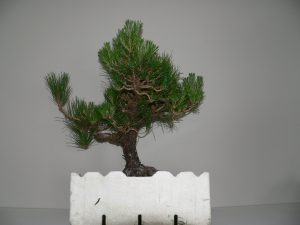
Black pine before
You can see that there was plenty of branches and foliage to choose from. The tree was well fed and healthy to cope with a major restyle.
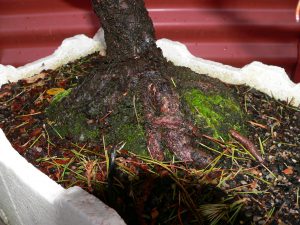
black pine nebari
After checking several options we decided to try to keep the current front because the nebari on this side is far better than the other side.
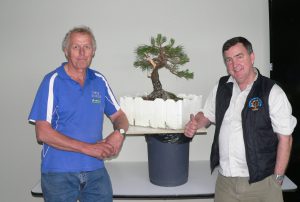
After
There were several options for trunk lines and we have used a fairly standard informal upright trunk line with some jin and shari.
The first branch had a really nice shape but was far too heavy for the remainder of the tree so it was 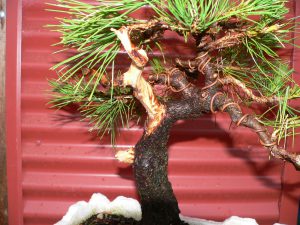 removed leaving a short jin.
removed leaving a short jin.
The apex of the tree leaned too far forward and was an awkward shape so it was also jinned. Because the old main trunk was so strong it had thickened the trunk in that area giving a slight reverse taper to the new trunk so a small area of shari surrounds the jin to reduce the visual weight and maintain better visual taper.
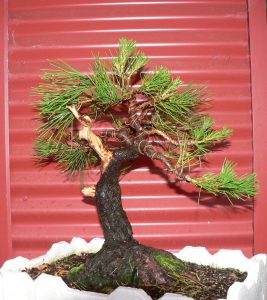
After the worshop
Spring should see this pine grow strongly. I’ll begin my pine maintenance schedule with this one now to try to maintain density and promote inner buds – Early summer candle pruning and needle plucking followed by autumn thinning and more needle plucking should produce more even energy distribution and promote shorter growth and smaller needles.
more bend, less snap
Sooner or later all bonsai growers need to bend parts of a bonsai. Whether the bend is in the trunk or just moving a branch slightly there is always some fear that the tree will break instead of bending the way you want it. Continue reading
Autumn pine work
The new shoots on Black pines have matured so it is time to thin out all the new shoots that have grown since decandling.
It is important to know that this is part of the technique used to REFINE MATURE pines. Younger, developing pines should be allowed to grow freely to gain strength and size and cut back hard every couple of years. Decandling is used to ramify the branches on trees that are closer to being mature bonsai. Continue reading
More from Pavel Slovak masterclass
As is usual at a bonsai workshop I came away with a few new ideas and techniques.
Pavel is noted for working with and, in particular, bending larger collected conifers. During the workshop he mentioned that bends are easier if you twist the branch while bending. Twisting as you bend allows the fibres in the wood to bend further without breaking.
He also mentioned that he often wraps electrical tape over the wire and raffia when making extreme bends. This serves to keep the moisture in a branch if it cracks while bending which he feels aids in healing the cracks and breaks.
Something I had not experienced before was removing ALL old needles from a pine in order to wire and shape the material. I have always attempted to retain as many old needles as possible hoping that some will produce new buds to help ramify the branching. It is certainly much easier to wire the branches without the older needles.
If anyone else has something from the recent NBPCA bonsai week feel free to let me know and I can add it here.
Pavel Masterclass
It was great to be accepted into the ‘lenders’ masterclass at the National Bonsai and Penjing Collection at Canberra last week. Continue reading
Juniper progress
This juniper started out as an upright variety with prickly bluish foliage. It spent a few years in the grow beds to get a thicker trunk and was transferred to a polystyrene fruit box for training. Continue reading
Twisted trunks
The first junipers I put into the grow beds were just allowed to grow freely. The result was stiff, straight branches that provided little inspiration, or opportunity, to create the sort of dynamic ‘wild’ junipers we see in Japanese literature.
About the same time Joe, nichigobonsai was talking about his experiences working in a Japanese bonsai nursery where they wired and bent large numbers of small junipers to start another batch of shohin twisted junipers. His comments showed me that junipers need to be treated differently to the other species I grow in order to produce inspirational bonsai stock. Continue reading
Triple trunk trident
This trident maple featured in this post was grown from 3 separate seedlings. They were planted close and held together until the separate trunks grafted themselves into a single trunk at the base. Multi trunk bonsai are not particularly common because every extra trunk adds complexity and the possibility of faults that would make the whole tree unattractive. Continue reading
Continue reading

